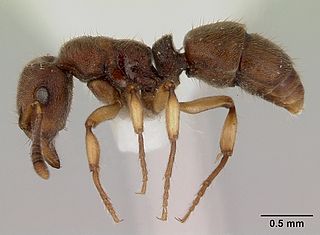
Heteroponera brouni is a species of ant in the genus Heteroponera. It is endemic to the North Island of New Zealand, and the Three Kings Islands.

Cephalopholis panamensis is a grouper fish from the Eastern Pacific Ocean. It is common and shy, and occasionally makes its way into the aquarium trade. It grows to a size of 31 cm in length.

Heteroponerinae is a subfamily of ants in the poneromorph subfamilies group containing three genera in one tribe. The subfamily was created in 2003 when Barry Bolton divided the Ponerinae subfamily into six subfamilies.
Heteroponera angulata is a species of ant in the genus Heteroponera, endemic to Brazil. It was described by Borgmeier in 1959.

Heteroponera carinifrons is a species of ant in the genus Heteroponera, endemic to Chile. It was described by Mayr in 1887.
Heteroponera crozieri is a species of ant in the genus Heteroponera endemic to Australia. Described in 2011, the workers look similar to those of Heteroponera leae, although H. leae ants are more southerly distributed.
Heteroponera dentinodis is a species of ant in the genus Heteroponera, endemic to Chile and Brazil. It was described by Mayr in 1887.
Heteroponera dolo is a species of ant in the genus Heteroponera, endemic to Argentina, Brazil, Paraguay and Uruguay. It was described by Roger in 1860.

Heteroponera flava is a species of ant in the genus Heteroponera. Endemic to Brazil and Paraguay, it was described by Kempf in 1962.
Heteroponera georgesi is a species of ant in the genus Heteroponera. Endemic to French Guiana, it was described by Perrault in 1999.
Heteroponera imbellis is a species of ant, in the genus Heteroponera. Endemic to Australia, it was described by Emery in 1895.

Heteroponera inca is a species of ant in the genus Heteroponera. Endemic to Colombia, it was described by William Louis Brown Jr. in 1958.
Heteroponera inermis is a species of ant in the genus Heteroponera. Endemic to Brazil, it was described by Emery in 1894.
Heteroponera leae is a species of ant in the genus Heteroponera. It is endemic to Australia, and was described by Wheeler in 1923. It has a similar appearance to Heteroponera crozieri ants, although H. crozieri ants are more northerly distributed.
Heteroponera majeri is a species of ant in the genus Heteroponera. Endemic to Australia, it was recently described by Taylor in 2011. Its appearance is far different to other Heteroponera species that reside in Australia.

Heteroponera mayri is a species of ant in the genus Heteroponera. Endemic to Brazil and Paraguay, it was described by Kempf in 1962.

Heteroponera microps is a species of ant in the genus Heteroponera. Endemic to South America, it was described by Borgmeier in 1957.
Heteroponera relicta is a species of ant in the genus Heteroponera. Endemic to Australia, it was described by Wheeler in 1915.
Heteroponera robusta is a species of ant in the genus Heteroponera. Endemic to Brazil, it was described by Kempf in 1962.









